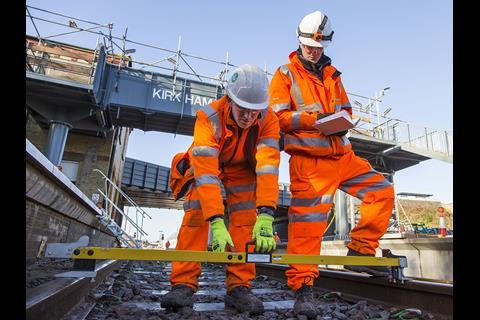UK: A strong focus on safety, reliability and performance underpins Network Rail’s objectives for the five-year Control Period 6, which starts on April 1 2019. Publishing its strategic business plan on February 13 for regulatory approval, the infrastructure manager explained how it expects to spend the £47bn allocated for CP6 by the UK and Scottish governments in their Statements of Funds Available, in order to meet the objectives set out in the earlier High-Level Output Specifications.
The Office of Rail & Road has started consulting on the plan, and NR’s efficiency targets before making a draft determination of funding needs and the level of track access charges for train operators. ORR is due to issue its draft determination in June for industry consultation, with a final determination to be published before the end of this year. Reflecting the devolution of responsibility within NR, there will be separate regulatory settlements for each of the geographical Routes as well as the System Operator and the headquarters functions.
According to NR Chief Executive Mark Carne, the development of the strategy has been very different from that for Control Period 5, where ambitious investment plans were derailed by the reclassification of the infrastructure manager as a public sector body, which limited its access to commercial financing. The CP6 plan has been developed ‘from the bottom up’, and is primarily focused on improving day to day operations, maintenance and renewals.
Within the overall budget, £18·5bn has been allocated for operations and maintenance, a 25% increase on CP5, and a similar sum for renewals. Another £10bn has been allocated for enhancements, mostly to cover the cost of completing committed schemes that have been carried over from CP5. Investment in digital railway initiatives such as traffic management and ETCS as well as other capacity improvements is expected to allow the network to accommodate an additional 1 000 trains per day from 2021.
Around £1bn has been allocated to support the planning and development of future enhancement projects which would be authorised and funded on a case by case basis once they are sufficiently mature. NR is looking at ways to identify new sources of funding that do not rely on central government support.
Describing the plan as ‘ambitious but realistic’, Carne said NR expected to work closely with train operators and other parties to ‘deliver the better railway that a better Britain needs’.
In terms of improved reliability, Carne said NR would ‘focus relentlessly on making our railway more reliable’. The plan anticipates a 15% reduction in the number of delayed trains. Rather than the current Public Performance Measure, which counts trains as ‘on time’ if they arrive at their final destination within 5 or 10 min of schedule, the industry will be moving to a ‘right time’ measurement of performance, including key intermediate stops; this will require a revision to timetable planning in order to ensure that the timings reflect actual performance including longer station dwell times as services get busier. Total passenger numbers are forecast to increase by around 40% by 2040.
Safety remains a key priority, and NR is looking for a further 10% reduction in the risk of train accidents, and reducing the risk at level crossings. There will be a continuing focus on improving workforce safety, and reducing the lost-time injury rates.



















